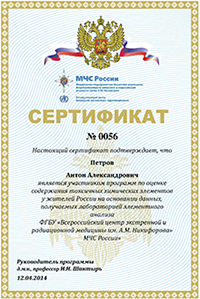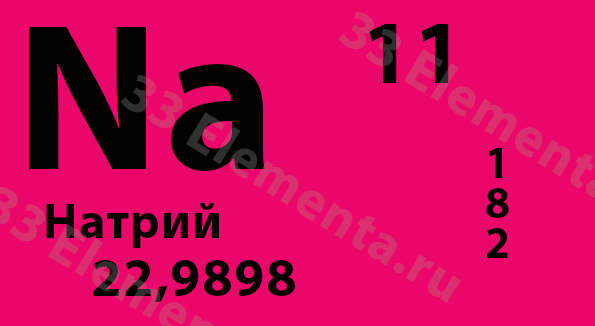It is important to know:
Why do people choose the Clinic of the Ministry of Emergency Situations?
Which steps necessary to do the test?
How to determine the amount of potassium in the human body
Dear friends!
This article is devoted to potassium (K), a vital macro element located under the number 19 in the periodic table.

This chemical element took its name from "potash", an English word which stands for the white granular powder, potassium carbonate. Potassium was discovered in 1807 by a talented Cornish chemist Humphry Davy.
Potassium is a silver-white, very light, soft and low-melting metal of essential nature, which means that it is not capable of self-generating in the human body but it must be present in the body in order to ensure its normal functioning. Potassium gets into the body with food which contains it.
Being Highly chemically active potassium is mostly found in the earth's crust, as it is included into the composition of various minerals and rocks qua various compounds. Thus, orthoclase or potassium feldspar is the most common substance. The dissolved form of potassium can be found in the natural form of sulfates and chlorides. Sea water, for instance, contains potassium chloride.
Being the main element of any living cell, potassium can be found in plants and mostly in fruit.
Potassium gets into the body through intestinal absorption (90-95%), it enters a liver with blood and then passes into a peripheral bloodstream. The most part of incoming potassium gets excreted with urine (80-90%) and feces (5-10%) and a trace amount gets excreted with sweat.
Potassium, located inside every cell, makes up 95-98% of its total amount, and the rest is located from outside the cell. Intracellular and extracellular potassium maintain the constant balance. It is this ratio of intracellular and extracellular potassium that ensures electrical nerve pulse advancing, controls muscle contractions, mainly the myocardium, and stabilizes blood pressure.
This function of potassium is essential for every living body!
The level of potassium in the blood plasma is mainly regulated by aldosterone and the nervous system. Skeletal muscles and liver act as the main organs of potassium depot.
Potassium plays the major role in the vital activity of the human body being in charge of such functions as regulation of intracellular metabolism, water and salt water metabolism, ensuring osmotic pressure and acid-base balance of the body, normalizing muscle work and transmitting the nervous impulses to muscles, excreting water and sodium, activating of a number of enzymes and participating in such important metabolic processes as energy production and synthesis of proteins, glycogen and glycoproteins, regulation of insulin secretion with pancreatic beta cells, ensuring sensitivity of smooth muscle cells to the vasoconstricting effect of angiotensin.
The daily requirement for potassium for an adult is 2–4 g. The lack of potassium as well as its exceeded level in the body can cause the major dysfunction of most human organs.
It is important to maintain the required amount of magnesium in the body, since its absence makes maintaining and depositing the vital level of potassium impossible.
It is especially important for the lovers of salty food to realize that when the level of sodium is exceeded, the body requires by one third energy more in order to maintain balance of potassium and sodium in the cell membranes.
The lack of potassium can be caused by long use of diuretic and hormonal drugs, addiction to caffeine, alcohol, very sweet food products, as well as stress, abundant vomiting, diarrhea and sweating. We can distinguish the following clinical symptoms the lack of potassium manifests itself with:
• fainting, weakness, fatigue, weakness;
• muscular dystrophy, paresis, limb tremor, hyperreflexia;
• low arterial and venous pressure, abnormal heart rhythm, degeneration and diffuse necrosis of myocard, abnormalities in ECG data;
• hallucinations;
• constipation, nausea, vomiting;
• shortness of breath, cough, pulmonary rale, poor expectoration, shallow diaphragmatic breathing;
• anorexia;
• atony of the bladder, nephrosis;
• high blood cholesterol;
• low glucose tolerance;
• dry skin, weak hair, etc.
The lack of potassium can also be manifested through such pathological conditions as performance decrement, insomnia, depression, arrhythmia, convulsions, ulcerative erosive lesion of mucous membranes, slow tissue regeneration, acne, growth inhibition, etc.
Since potassium gets excreted with sweat, athletes and residents of tropical countries should constantly replenish its level with special drinks and healthcare products.
Coffee and alcohol also have a great effect on the rate of potassium exporting through kidneys and can gradually cause the lack of this trace element.
The exceeded level of potassium can manifest itself through the following symptoms and provoke such pathological conditions of the body as:
• anxiety, discomfort;
• flaccid paralysis;
• paresthesia, i.e. numbness or tingling of the skin;
• muscle weakness (adynamia);
• low amount of excreted urine (oliguria);
• accumulation of nitrogenous metabolic products (azotemia);
• detection of protein (proteinuria) and blood (hematuria) in urine;
• chronic renal failure;
• gray-pale skin color;
• lack of air (dyspnea);
• abdominal pain, nausea, vomiting, diarrhea;
• paroxysmal tachycardia, ventricular bradycardia;
• neurosis, neurocirculatory dystonia;
• arrhythmia, arterial hypertension;
• diabetes;
• small bowel disorders;
• gluten protein intolerance;
• degenerative neuromuscular disorders, etc.
Among the other pathologies an eye should be especially keep on are atrial fibrillation, which could lead to the cardiac arrest in the diastole phase and benign and malignant tumors.
With reference to the above-mentioned facts any deviation from the required level of potassium in the body not only irreversibly violates functioning of organs, but it also can cause death. Therefore, it is crucial to control the optimum balance of potassium in your body.
Analyzing the requests made by the consumers regarding potassium, we have detected the following variations:
• how to determine the lack of potassium in the body;
• how to check the level of potassium in the body at home;
• how to check the level of potassium in the body, analyzes;
• how to recognize potassium deficiency in the body;
• how to check the presence of potassium in the body at home;
• how to determine potassium in the human body;
• how to determine the limit of potassium normal for the human body;
• how to learn the level of potassium present in the human body.
• how to determine the amount of potassium in the human body;
• how to replete potassium in the body;
Answering the question of “how to learn the level of potassium present in the human body?”, we should recommend you the unique state-accredited research methodology providing the most accurate data on the number of trace and major elements present in the human body. This method is based on studying the inorganic samples (nails, hair, teeth, etc.) with spectral analysis (coupled plasma mass spectrometry).
Along with a quantitative data on potassium this test will provide you with a complete distribution picture of the other 32 microelements present in your body, making possible to detect and treat the current pathologies, diagnose and prevent them from appearing in future by correcting the bioelemental status of your body.
It is especially important to control the normal bioelemental status of the newborn children until their bodies get the complete formed.
The uniqueness of the method of coupled plasma mass spectrometry, based on studying the inorganic samples in contrast to studying the organic matter (blood, urine, saliva, etc.) results from the fact that the greatest number of vital and toxic trace elements get deposited primarily in human tissues and bones, and, therefore, their correct quantitative proportions cannot be detected in organic samples.
Toxic trace elements get systematically accumulated in the tissues, organs, bones and other body structures, therefore it is impossible to detect their exact presence through studies of the organic samples such as urine, blood, cerebrospinal fluid, saliva, etc.
It also applies to the detection of the vital trace elements when their exact quantity needs to be determined in order to build an overall picture of the bioelemental status qua the aggregate of vital and toxic elements.
That is exactly why the unique laboratory of elemental analysis aimed at detecting and monitoring the presence of toxic trace elements in the human body of was launched within the Clinic of the Ministry of Emergency Situations in 2007. The service was initially meant for employees of the huge structure accountable to the Ministry of Emergency Situations.
The spectral analysis (you can learn more about the method by clicking this link http://www.mineralogram.com/bioelementnyystatus.html) is a unique method which provides the most accurate information both on vital and toxic trace elements, present in a human body, which makes it possible to study the wide range of indicators instead of focusing on a certain single chemical element.
You can look into an example of the study done through the method of the spectral analysis by clicking this link.
It is a matter of great importance, since the trace elements constitute a single system and the lack of some elements causes the accumulation of the others, which results in replacement of the certain elements with the other once.
As you might see, our project is fully devoted to the spectral analysis and its principle with regard to health control. We will gladly assist you at every step of this study, elucidate the obtained results and, if necessary, advise you on how to restore the elemental status of your body.
Our experts will be happy to answer any questions you may have regarding the method of spectral analysis!
The uniqueness of this method makes it possible to study samples sent from any part of the world as a usual letter. It is a truly unique tool of the health control.
Remember that the systematic control over the vital sighs it is the major step on the way to well-being and longevity.
We would like to thank you for your kind attention!
Yours faithfully, 33 Elementa.Ru
Publications
Is eating with a silver spoon bad for health of children and adults? Myth or real danger to the bodyRead >>
At the present review we do akcent on question: – “Why do patients choose the Clinic of the Ministry of Emergency Situations of Russia? ”.Read >>
The concept of the health control as a factor of the awareness of the body-related issues and the proper attitude towards themRead >>





